Examining the Non-Covalent Interactions for Two Polymorphs of a 2,1,3-benzoxadiazole Derivative
Abstract
:1. Introduction
2. Discussion
2.1. Hirshfeld Surface Analysis and Void Space
2.2. Interactions from the Carbonyl Group
2.3. Interactions from/with the Piperazine
2.4. Energy Frameworks
2.5. Computational Studies
3. Conclusions
4. Experimental Section
5. Spectroscopy
6. Single Crystal Diffraction
7. Computational Studies
Supplementary Materials
Author Contributions
Funding
Conflicts of Interest
References
- Cruz-Cabeza, A.J.; Bernstein, J. Conformational Polymorphism. Chem. Rev. 2014, 114, 2170–2191. [Google Scholar] [CrossRef]
- Nangia, A. Conformational Polymorphism in Organic Crystals. Acc. Chem. Res. 2008, 41, 595–604. [Google Scholar] [CrossRef] [PubMed]
- Kersten, K.; Kaur, R.; Matzger, A. Survey and analysis of crystal polymorphism in organic structures. IUCrJ 2018, 5, 124–129. [Google Scholar] [CrossRef] [PubMed]
- Cruz-Cabeza, A.J.; Feeder, N.; Davey, R.J. Open questions in organic crystal polymorphism. Commun. Chem. 2020, 3, 142. [Google Scholar] [CrossRef]
- Beran, G.J.O.; Sugden, I.J.; Greenwell, C.; Bowskill, D.H.; Pantelides, C.C.; Adjiman, C.S. How many more polymorphs of ROY remain undiscovered. Chem. Sci. 2022, 13, 1288–1297. [Google Scholar] [CrossRef]
- Lévesque, A.; Maris, T.; Wuest, J.D. ROY Reclaims Its Crown: New Ways to Increase Polymorphic Diversity. J. Am. Chem. Soc. 2020, 142, 11873–11883. [Google Scholar] [CrossRef]
- Chistyakov, D.; Sergeev, G. The Polymorphism of Drugs: New Approaches to the Synthesis of Nanostructured Polymorphs. Pharmaceutics 2020, 12, 34. [Google Scholar] [CrossRef]
- Themed issue: Polymorphism and crystal forms. N. J. Chem. 2008, 32, 1657–1658. [CrossRef]
- Nogueira, B.A.; Castiglioni, C.; Fausto, R. Color polymorphism in organic crystals. Commun. Chem. 2020, 3, 34. [Google Scholar] [CrossRef]
- McKinnon, J.J.; Fabbiani, F.P.A.; Spackman, M.A. Comparison of Polymorphic Molecular Crystal Structures through Hirshfeld Surface Analysis. Cryst. Growth Des. 2007, 7, 755–769. [Google Scholar] [CrossRef]
- Bourne, S.A. Intermolecular Interactions in Crystals: Fundamentals of Crystal Engineering; Novoa, J.J., Ed.; The Royal Society of Chemistry: London, UK, 2018. [Google Scholar]
- Desiraju, G.R.; Vittal, J.J.; Ramanan, A. Crystal Engineering; Indian Institute of Science: Bangalore, India; Singapore, 2011. [Google Scholar] [CrossRef]
- Gavezzotti, A. Molecular Aggregation: Structure Analysis and Molecular Simulation of Crystals and Liquids; IUCr Monographs on Crystallography; Oxford University Press: Oxford, UK; New York, NY, USA, 2007. [Google Scholar]
- Dunitz, J.D.; Gavezzotti, A. Supramolecular Synthons: Validation and Ranking of Intermolecular Interaction Energies. Cryst. Growth Des. 2012, 12, 5873–5877. [Google Scholar] [CrossRef]
- Galli, S. X-ray Crystallography: One Century of Nobel Prizes. J. Chem. Educ. 2014, 91, 2009–2012. [Google Scholar] [CrossRef]
- Hargittai, I. Crystallography in Structural Chemistry. Struct. Chem. 2014, 25, 1321–1326. [Google Scholar] [CrossRef]
- Vologzhanina, A.V. Intermolecular Interactions in Functional Crystalline Materials: From Data to Knowledge. Crystals 2019, 9, 478. [Google Scholar] [CrossRef]
- Spackman, M.A.; Spackman, P.R.; Thomas, S.P. 13 Beyond Hirshfeld surface analysis: Interaction energies, energy frameworks and lattice energies with CrystalExplorer. In Complementary Bonding Analysis; Grabowsky, S., Ed.; De Gruyter: Berlin, Germany, 2021; pp. 329–352. [Google Scholar] [CrossRef]
- Saha, S.; Samanta, A. Photophysical and Dynamic NMR Studies on 4-Amino-7-nitrobenz-2-oxa-1, 3-diazole Derivatives: Elucidation of the Nonradiative Deactivation Pathway. J. Phys. Chem. A 1998, 102, 7903–7912. [Google Scholar] [CrossRef]
- Saha, S. 4-Amino derivatives of 7-nitro-2,1,3-benzoxadiazole: The effect of the amino moiety on the structure of fluorophores. Acta Crystallogr. Sect. C Cryst. Struct. Commun. 2002, 58, o174–o177. [Google Scholar] [CrossRef]
- Gavezzotti, A. Computational Studies of Crystal Structure and Bonding. In Advanced X-ray Crystallography; Rissanen, K., Ed.; Springer: Berlin/Heidelberg, Germany, 2012; pp. 1–32. [Google Scholar] [CrossRef]
- Desiraju, G.R. Supramolecular Synthons in Crystal Engineering—A New Organic Synthesis. Angew. Chem. Int. Ed. 1995, 34, 2311–2327. [Google Scholar] [CrossRef]
- Spackman, M.A.; McKinnon, J.J. Fingerprinting intermolecular interactions in molecular crystals. CrystEngComm 2002, 4, 378–392. [Google Scholar] [CrossRef]
- Tan, S.L.; Jotani, M.M.; Tiekink, E.R.T. Utilizing Hirshfeld surface calculations, non-covalent interaction (NCI) plots and the calculation of interaction energies in the analysis of molecular packing. Acta Crystallogr. Sect. E Crystallogr. Commun. 2019, 75, 308–318. [Google Scholar] [CrossRef]
- McKinnon, J.J.; Spackman, M.A.; Mitchell, A.S. Novel tools for visualizing and exploring intermolecular interactions in molecular crystals. Acta Crystallogr. Sect. B Struct. Sci. 2004, 60, 627–668. [Google Scholar] [CrossRef]
- Bauzá, A.; Mooibroek, T.J.; Frontera, A. Directionality of π-holes in nitro compounds. Chem. Commun. 2015, 51, 1491–1493. [Google Scholar] [CrossRef] [PubMed]
- Franconetti, A.; Frontera, A.; Mooibroek, T.J. Intramolecular π–hole interactions with nitro aromatics. CrystEngComm 2019, 21, 5410–5417. [Google Scholar] [CrossRef]
- Bauzá, A.; Frontera, A.; Mooibroek, T.J. π-Hole Interactions Involving Nitro Aromatic Ligands in Protein Structures. Chem. Eur. J. 2019, 25, 13436–13443. [Google Scholar] [CrossRef] [PubMed]
- Sahariah, B.; Sarma, B.K. Relative orientation of the carbonyl groups determines the nature of orbital interactions in carbonyl–carbonyl short contacts. Chem. Sci. 2019, 10, 909–917. [Google Scholar] [CrossRef]
- Yang, S.; Garner, A.C.; Wallis, J.D. N–H⋯O hydrogen bonding to the alkoxy oxygen of a carboxylic ester group: Crystal structures of methyl 2,6-diaminobenzoate and its derivatives. CrystEngComm 2020, 22, 3701–3712. [Google Scholar] [CrossRef]
- Molčanov, K.; Kojić-Prodić, B.; Raos, N. Analysis of the less common hydrogen bonds involving ester oxygen sp 3 atoms as acceptors in the crystal structures of small organic molecules. Acta Crystallogr. Sect. B Struct. Sci. 2004, 60, 424–432. [Google Scholar] [CrossRef] [PubMed]
- Johnstone, R.; Loureiro, R.; Cristiano, M.; Labat, G. Bond Energy/Bond Order Relationships for N-O Linkages and a Quanti-tative Measure of Ionicity: The Role of Nitro Groups in Hydrogen-Bonding. Ark. Arch. Org. Chem. 2010, 5, 142–169. [Google Scholar]
- Dunitz, J.D.; Gavezzotti, A. How molecules stick together in organic crystals: Weak intermolecular interactions. Chem. Soc. Rev. 2009, 38, 2622–2633. [Google Scholar] [CrossRef] [PubMed]
- Turner, M.J.; Thomas, S.P.; Shi, M.W.; Jayatilaka, D.; Spackman, M.A. Energy frameworks: Insights into interaction anisotropy and the mechanical properties of molecular crystals. Chem. Commun. 2015, 51, 3735–3738. [Google Scholar] [CrossRef]
- Murray, J.S.; Politzer, P. The electrostatic potential: An overview. WIREs Comput. Mol. Sci. 2011, 1, 153–163. [Google Scholar] [CrossRef]
- Spackman, M.A.; McKinnon, J.J.; Jayatilaka, D. Electrostatic potentials mapped on Hirshfeld surfaces provide direct insight into intermolecular interactions in crystals. CrystEngComm 2008, 10, 377–388. [Google Scholar] [CrossRef]
- Muratov, E.N.; Bajorath, J.; Sheridan, R.P.; Tetko, I.V.; Filimonov, D.; Poroikov, V.; Oprea, T.I.; Baskin, I.I.; Varnek, A.; Roitberg, A.; et al. QSAR without borders. Chem. Soc. Rev. 2020, 49, 3525–3564. [Google Scholar] [CrossRef] [PubMed]
- Ismail, I.; Chen, Z.; Sun, L.; Ji, X.; Ye, H.; Kang, X.; Huang, H.; Song, H.; Bolton, S.G.; Xi, Z.; et al. Highly efficient H2S scavengers via thiolysis of positively-charged NBD amines. Chem. Sci. 2020, 11, 7823–7828. [Google Scholar] [CrossRef]
- De Almeida, R.F.M.; Santos, T.C.B.; da Silva, L.C.; Suchodolski, J.; Krasowska, A.; Stokowa-Sołtys, K.; Puchalska, M.; Starosta, R. NBD derived diphenyl(aminomethyl)phosphane—A new fluorescent dye for imaging of low pH regions and lipid membranes in living cells. Dye. Pigment. 2021, 184, 108771. [Google Scholar] [CrossRef]
- Bruker. Apex3 V2019.1-0, SAINT V8.40A; Bruker AXS Inc.: Madison, WI, USA, 2019. [Google Scholar]
- Krause, L.; Herbst-Irmer, R.; Sheldrick, G.M.; Stalke, D. Comparison of silver and molybdenum microfocus X-ray sources for single-crystal structure determination. J. Appl. Crystallogr. 2015, 48, 3–10. [Google Scholar] [CrossRef]
- Bruker, AXS Inc. SHELXTL Suite of Programs, Version 6.14; Bruker Advanced X-Ray Solutions; Bruker AXS Inc.: Madison, WI, USA, 2000–2003. [Google Scholar]
- Sheldrick, G.M. A short history of SHELX. Acta Crystallogr. Sect. A 2008, A64, 112–122. [Google Scholar] [CrossRef]
- Sheldrick, G.M. SHELXT—Integrated space-group and crystal-structure determination. Acta Crystallogr. Sect. A Found. Adv. 2015, 71, 3–8. [Google Scholar] [CrossRef]
- Sheldrick, G.M. Crystal structure refinement with SHELXL. Acta Crystallogr. Sect. C Struct. Chem. 2015, C71, 3–8. [Google Scholar] [CrossRef]
- Hübschle, C.B.; Sheldrick, G.M.; Dittrich, B. ShelXle: A Qt graphical user interface for SHELXL. J. Appl. Crystallogr. 2011, 44, 1281–1284. [Google Scholar] [CrossRef]
- Dolomanov, O.V.; Bourhis, L.J.; Gildea, R.J.; Howard, J.A.K.; Puschmann, H. OLEX2: A complete structure solution, refinement and analysis program. J. Appl. Cryst. 2009, 42, 339–341. [Google Scholar] [CrossRef]
- Mardirossian, N.; Head-Gordon, M. ωB97X-V: A 10-parameter, range-separated hybrid, generalized gradient approximation density functional with nonlocal correlation, designed by a survival-of-the-fittest strategy. Phys. Chem. Chem. Phys. 2014, 16, 9904–9924. [Google Scholar] [CrossRef] [PubMed]
- Spackman, P.R.; Turner, M.J.; McKinnon, J.J.; Wolff, S.K.; Grimwood, D.J.; Jayatilaka, D.; Spackman, M.A. CrystalExplorer: A program for Hirshfeld surface analysis, visualization and quantitative analysis of molecular crystals. J. Appl. Crystallogr. 2021, 54, 1006–1011. [Google Scholar] [CrossRef] [PubMed]
- Macrae, C.F.; Bruno, I.J.; Chisholm, J.A.; Edgington, P.R.; McCabe, P.; Pidcock, E.; Rodriguez-Monge, L.; Taylor, R.; van de Streek, J.; Wood, P.A. Mercury CSD 2.0–new features for the visualization and investigation of crystal structures. J. Appl. Crystallogr. 2008, 41, 466–470. [Google Scholar] [CrossRef]
- Mackenzie, C.F.; Spackman, P.R.; Jayatilaka, D.; Spackman, M.A. CrystalExplorer model energies and energy frameworks: Extension to metal coordination compounds, organic salts, solvates and open-shell systems. IUCrJ 2017, 4, 575–587. [Google Scholar] [CrossRef]
- Jayatilaka, D.; Grimwood, D.J. Tonto: A Fortran Based Object-Oriented System for Quantum Chemistry and Crystallography. In Computational Science—ICCS 2003; Sloot, P.M.A., Abramson, D., Bogdanov, A.V., Gorbachev, Y.E., Dongarra, J.J., Zomaya, A.Y., Eds.; Springer: Berlin/Heidelberg, Germany, 2003; pp. 142–151. [Google Scholar]
- Johnson, E.R.; Keinan, S.; Mori-Sánchez, P.; Contreras-García, J.; Cohen, A.J.; Yang, W. Revealing Noncovalent Interactions. J. Am. Chem. Soc. 2010, 132, 6498–6506. [Google Scholar] [CrossRef]
- Lu, T.; Chen, F. Multiwfn: A multifunctional wavefunction analyzer. J. Comput. Chem. 2012, 33, 580–592. [Google Scholar] [CrossRef]
- Humphrey, W.; Dalke, A.; Schulten, K. VMD: Visual molecular dynamics. J. Mol. Graph. 1996, 14, 33–38. [Google Scholar] [CrossRef]
- Neese, F. Software update: The ORCA program system, version 4.0. Wiley Interdiscip. Rev. Comput. Mol. Sci. 2018, 8, e1327. [Google Scholar] [CrossRef]
- Rappoport, D.; Furche, F. Property-optimized Gaussian basis sets for molecular response calculations. J. Chem. Phys. 2010, 133, 134105. [Google Scholar] [CrossRef]
- Hellweg, A.; Rappoport, D. Development of new auxiliary basis functions of the Karlsruhe segmented contracted basis sets including diffuse basis functions (def2-SVPD, def2-TZVPPD, and def2-QVPPD) for RI-MP2 and RI-CC calculations. Phys. Chem. Chem. Phys. 2015, 17, 1010–1017. [Google Scholar] [CrossRef]
- Kleemiss, F.; Dolomanov, O.V.; Bodensteiner, M.; Peyerimhoff, N.; Midgley, L.; Bourhis, L.J.; Genoni, A.; Malaspina, L.A.; Jayatilaka, D.; Spencer, J.L.; et al. Accurate crystal structures and chemical properties from NoSpherA2. Chem. Sci. 2021, 12, 1675–1692. [Google Scholar] [CrossRef] [PubMed]
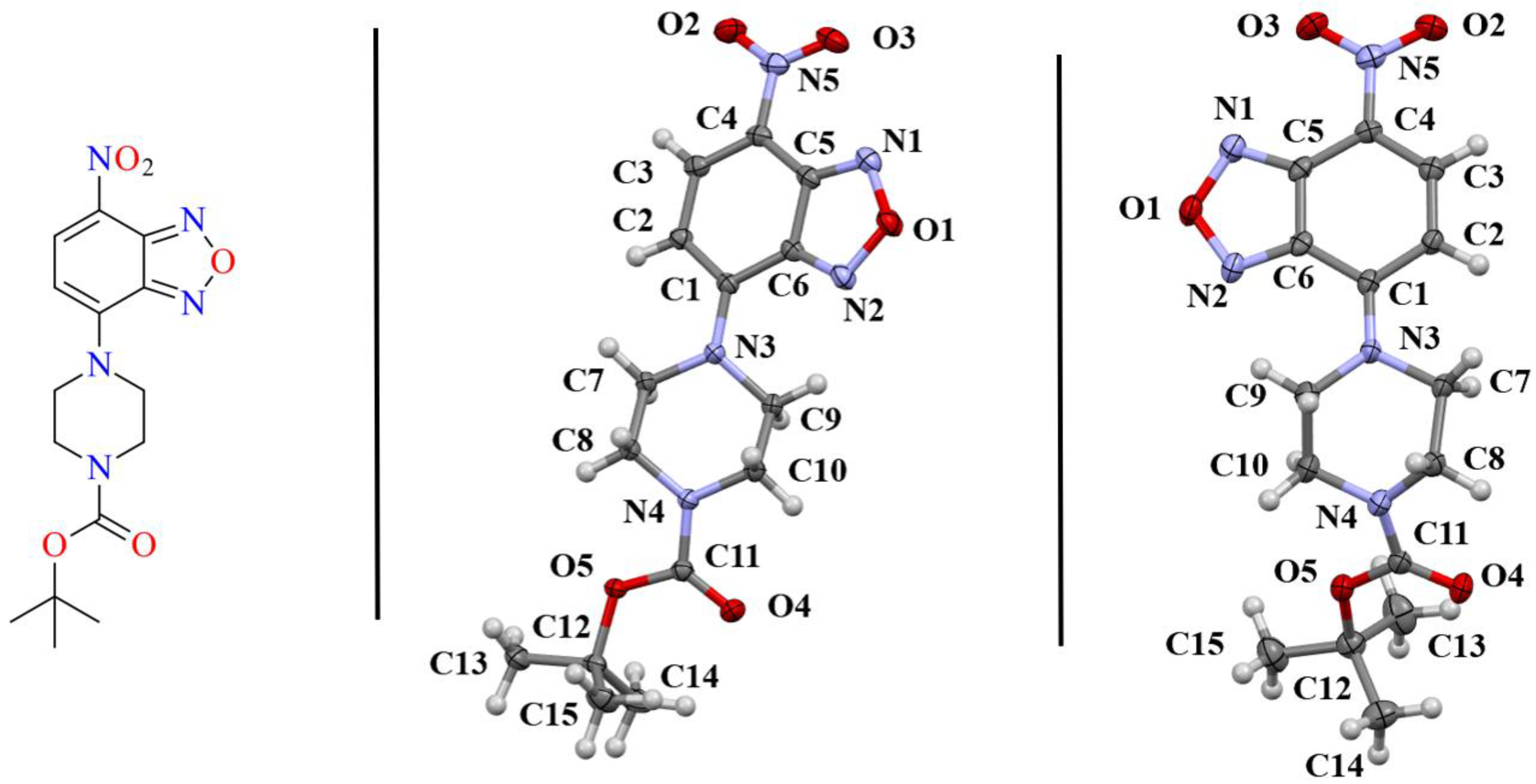
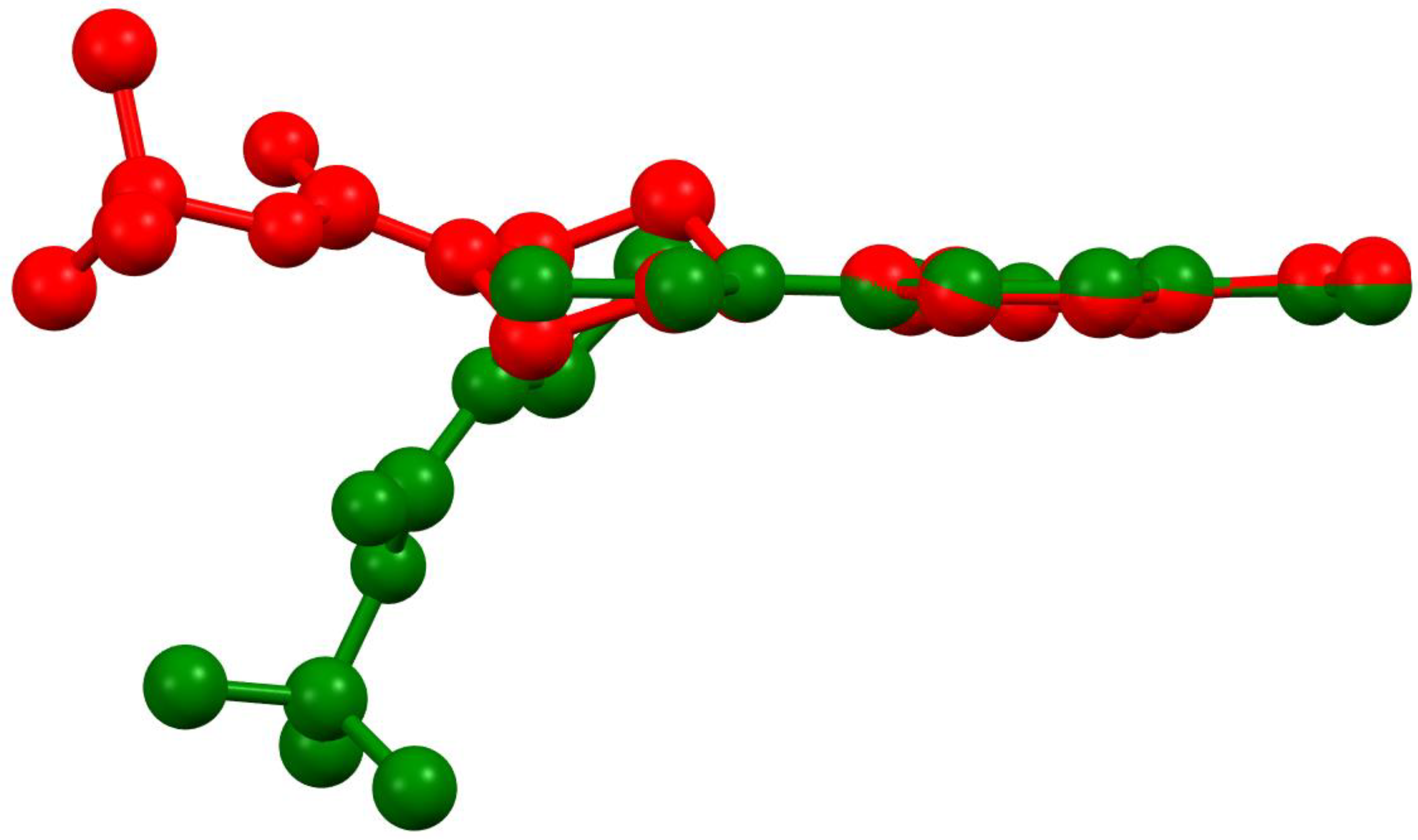




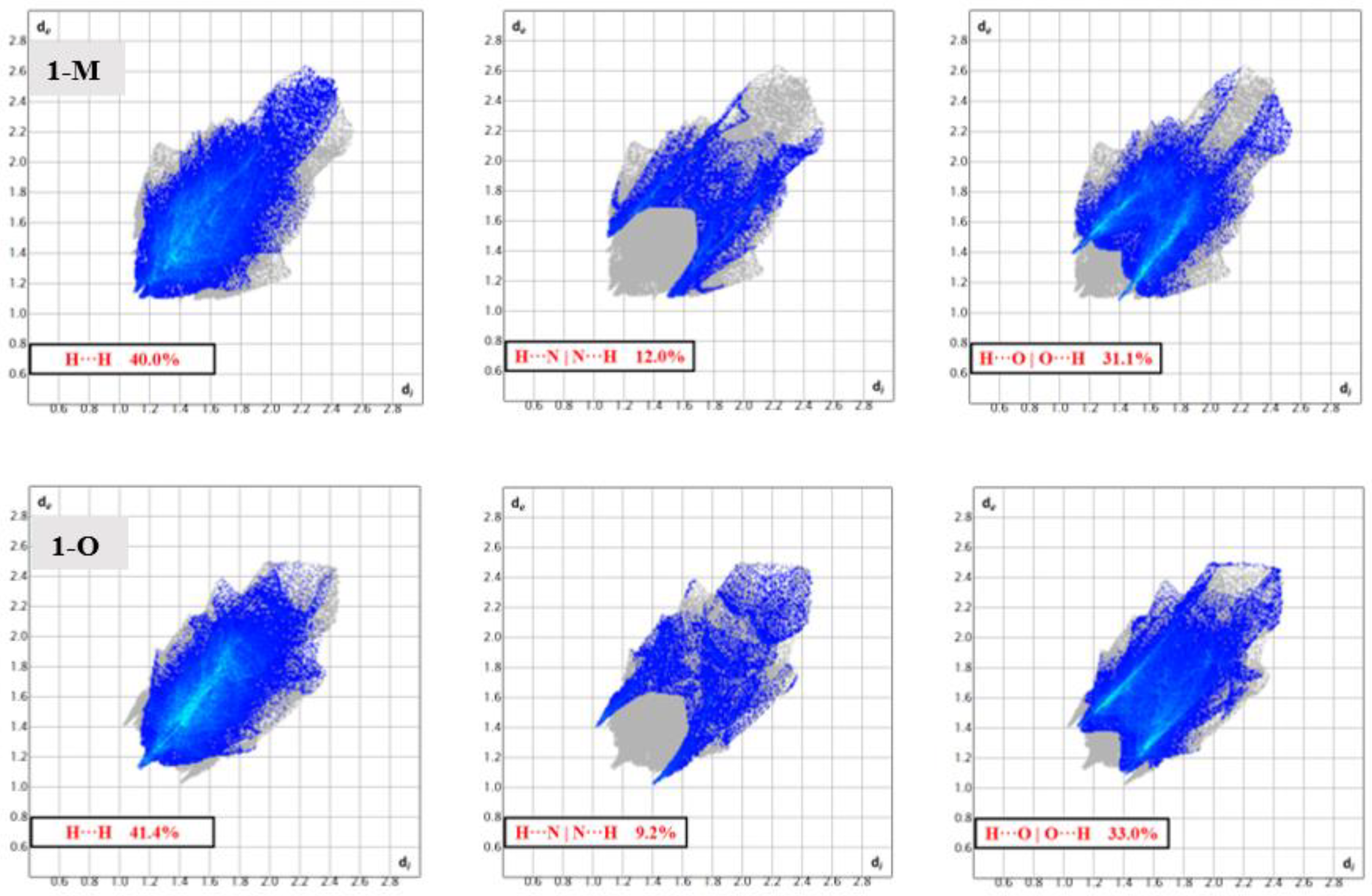

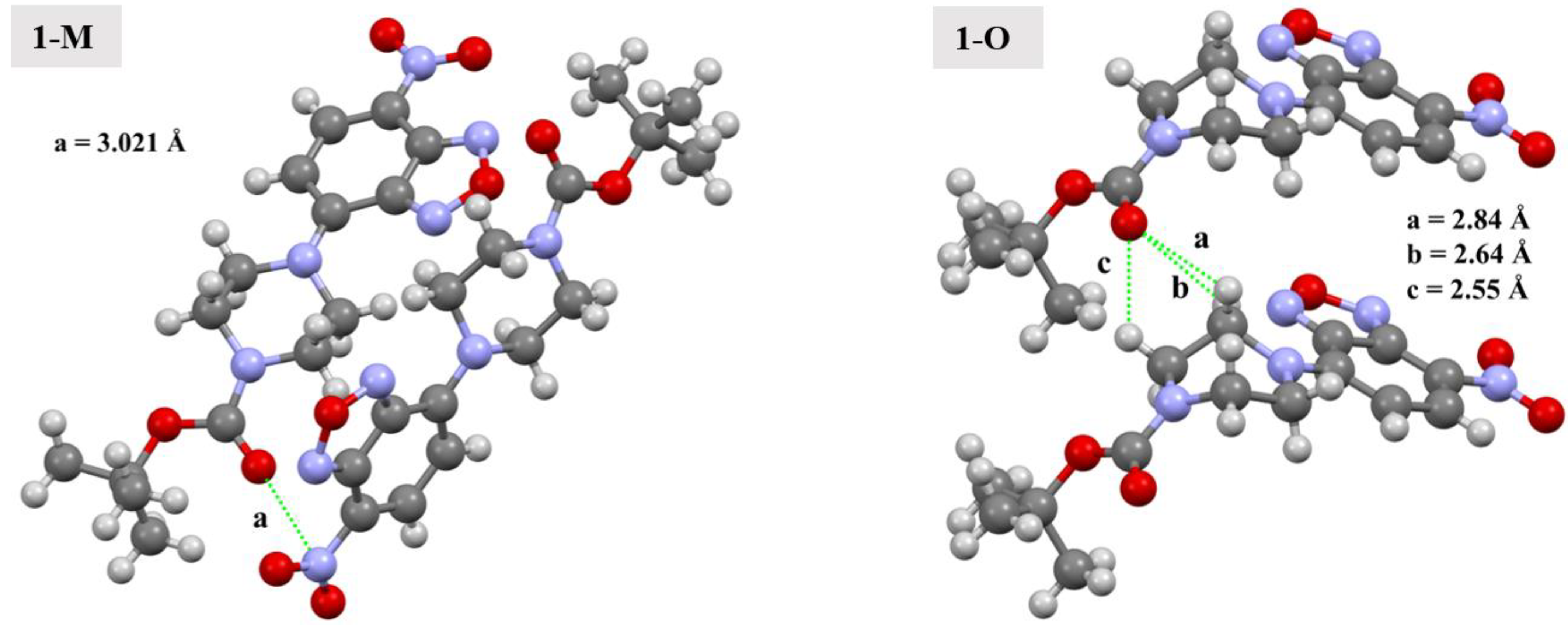
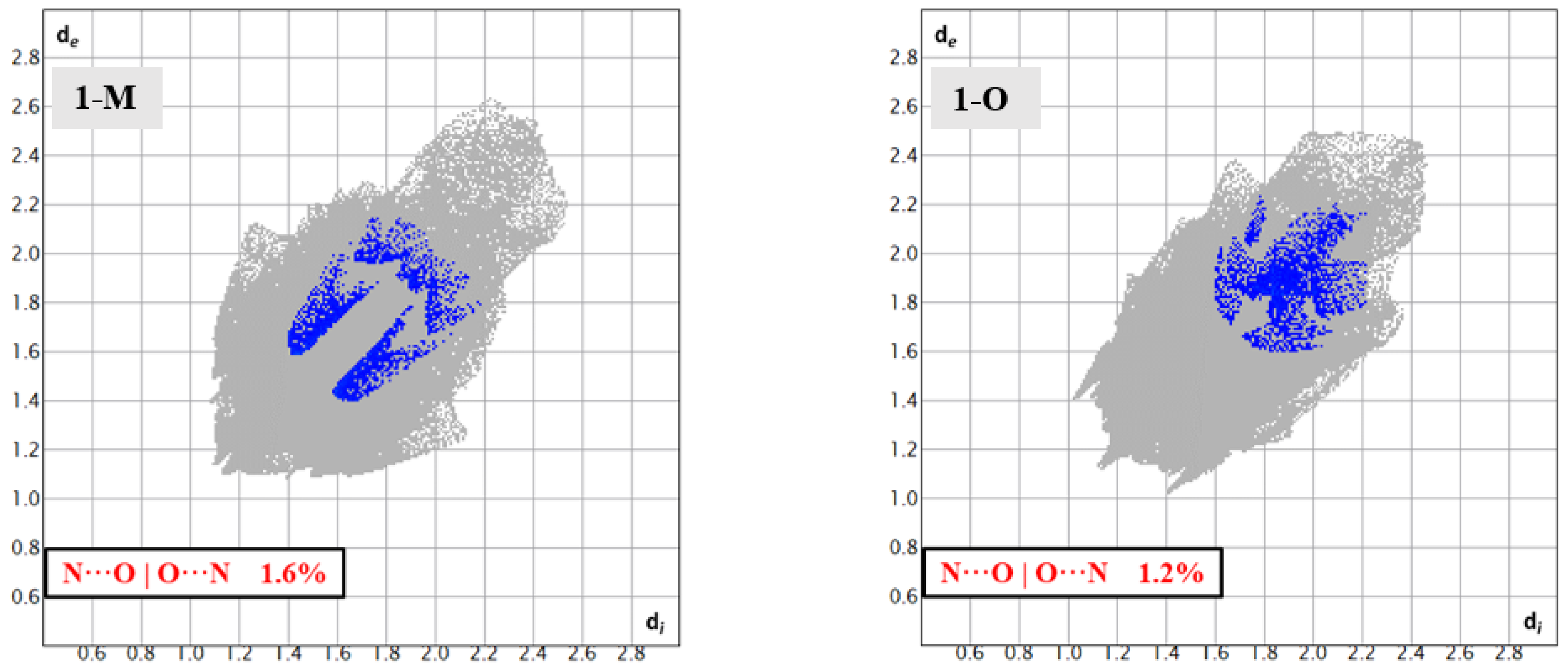

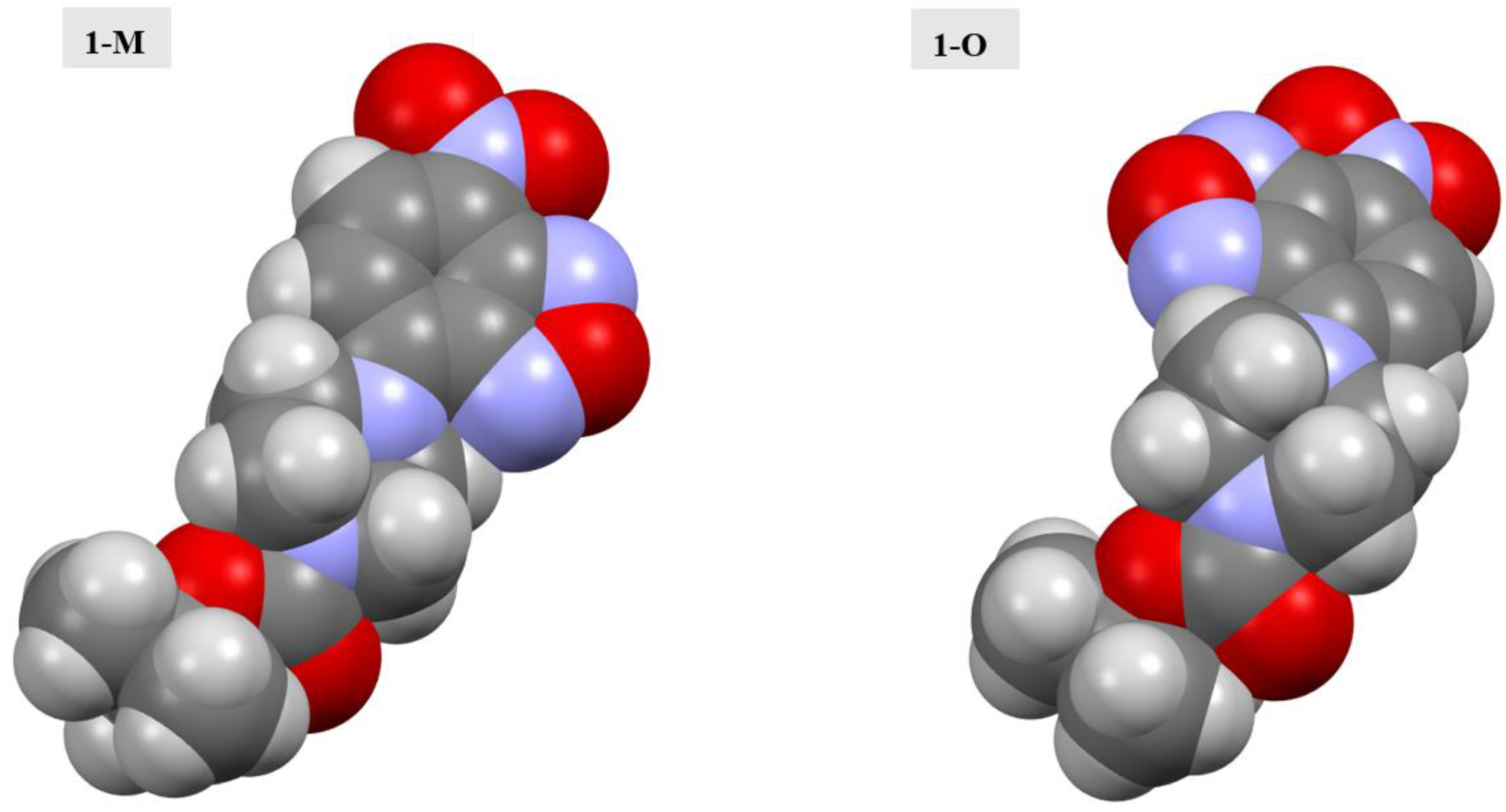
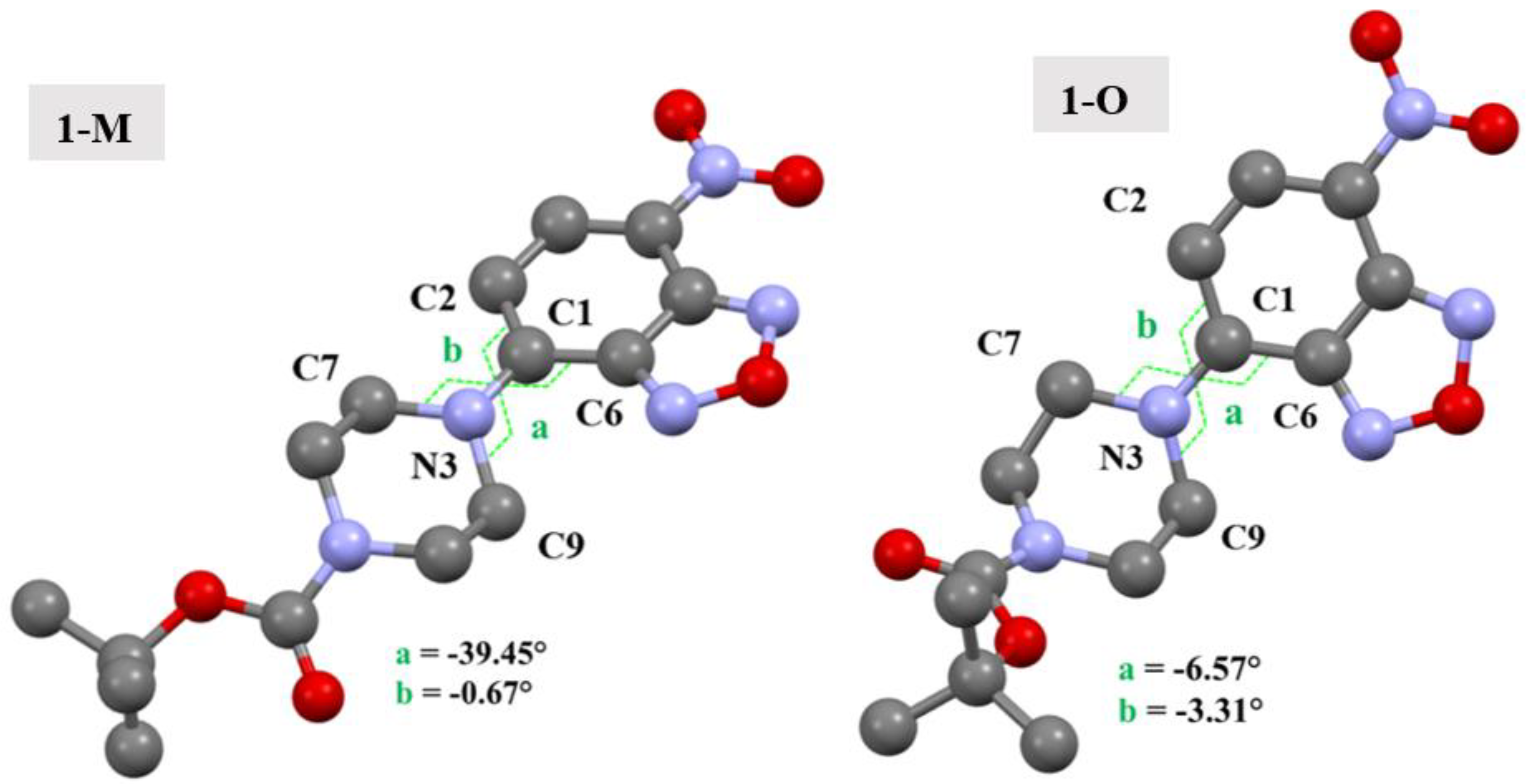
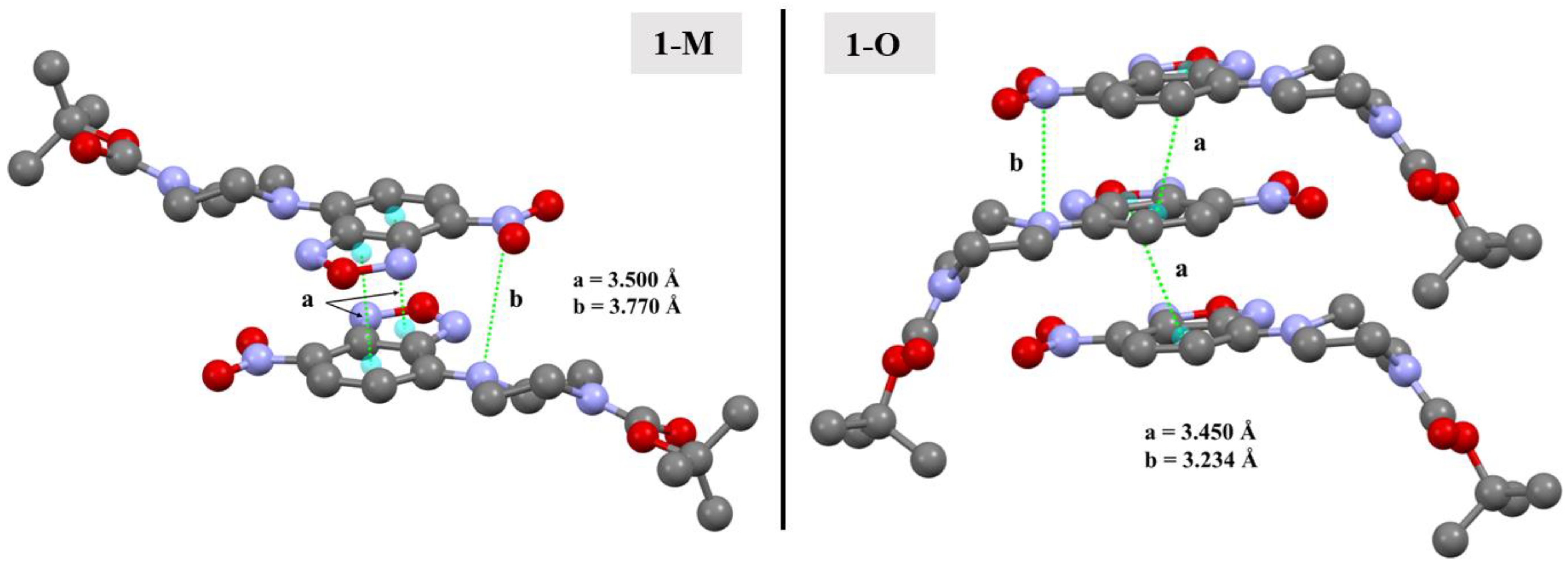
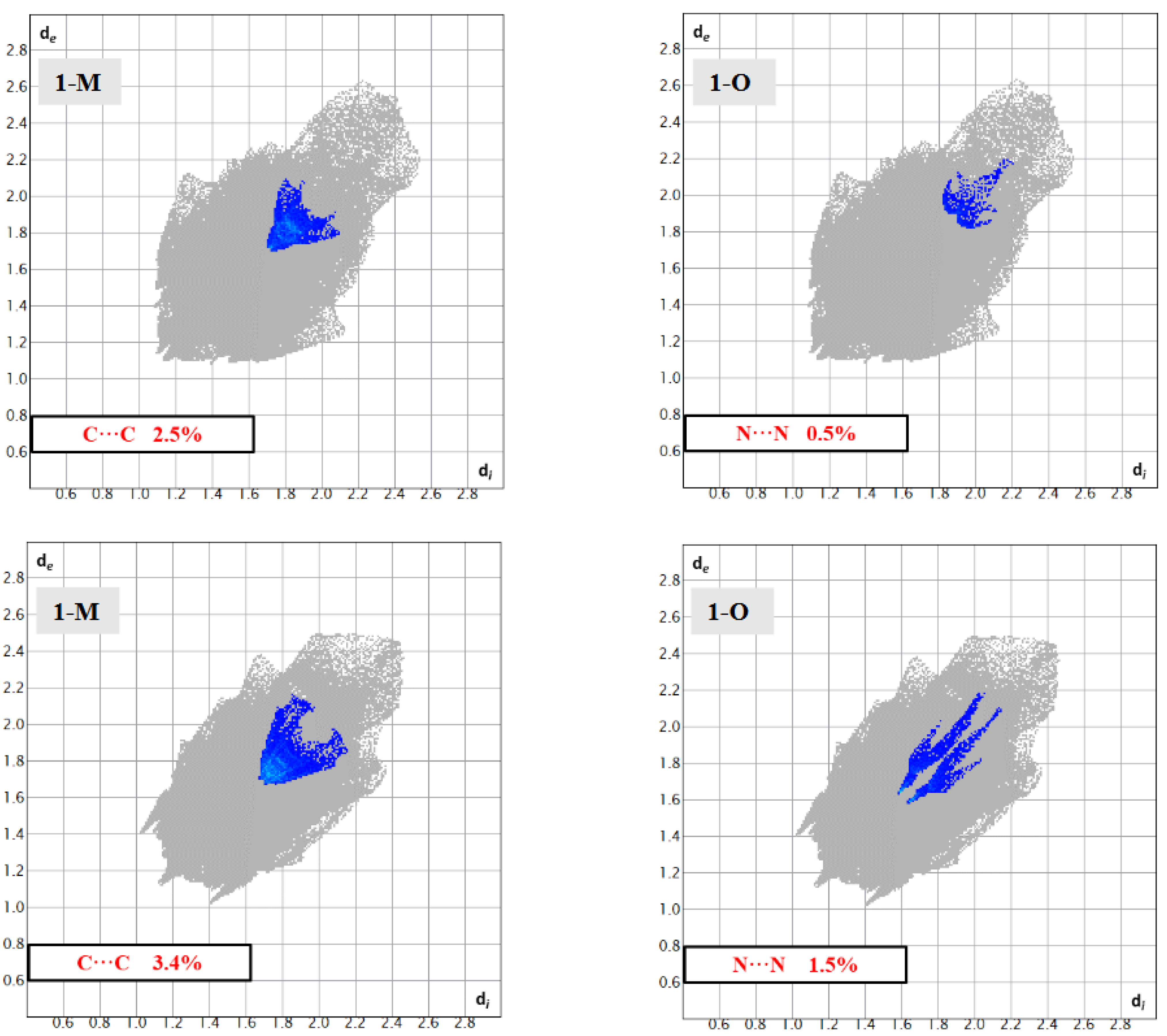
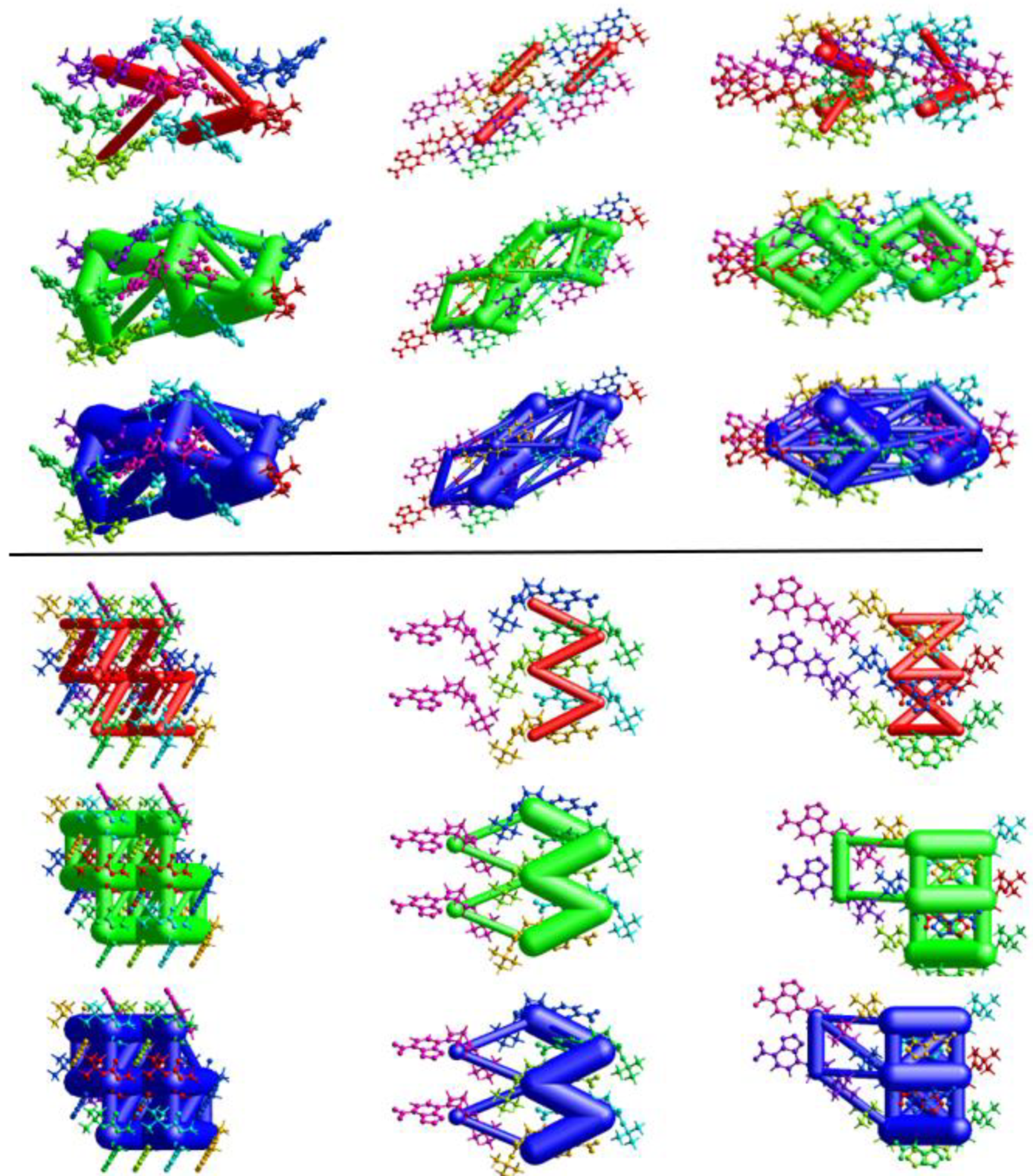
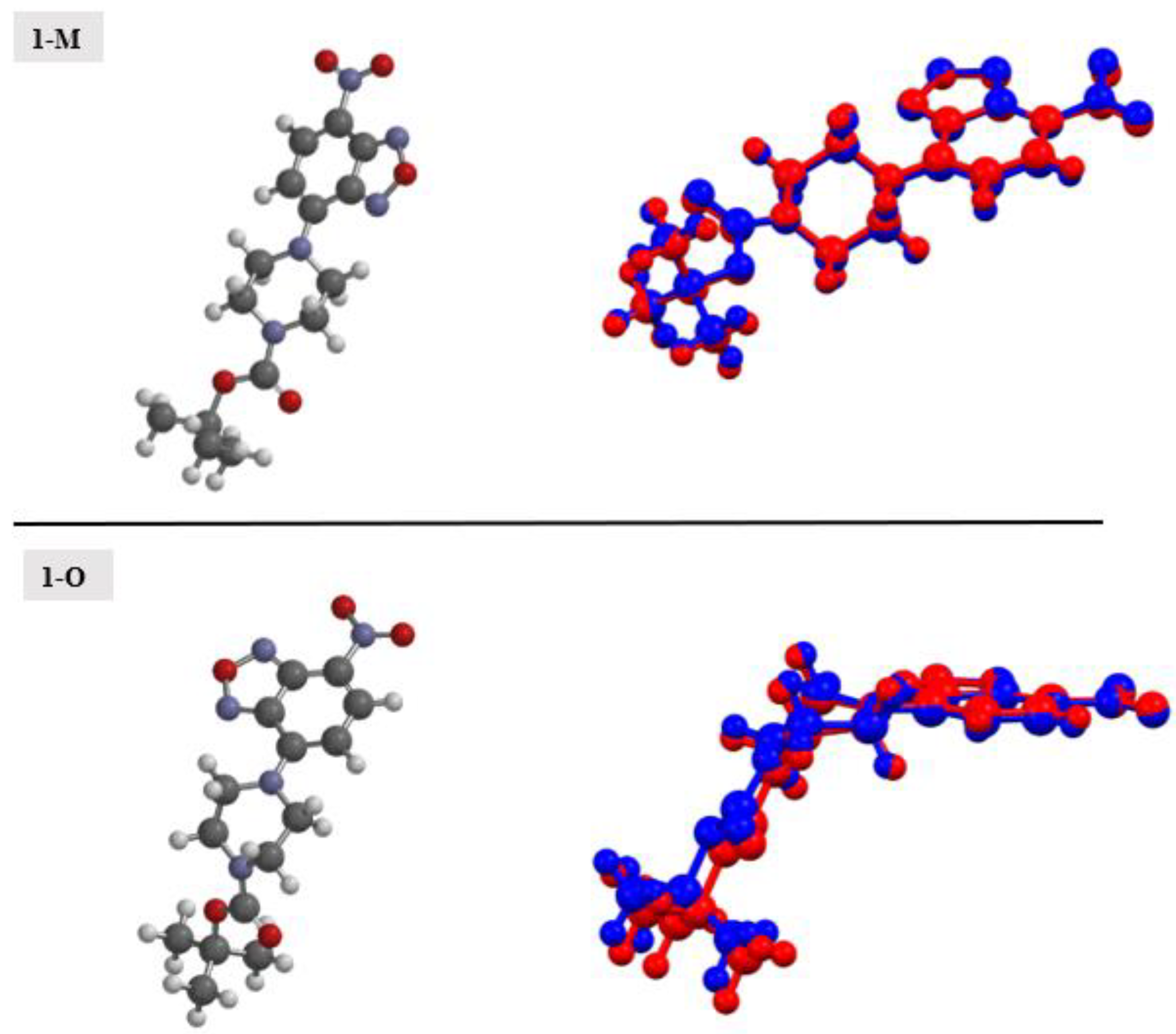
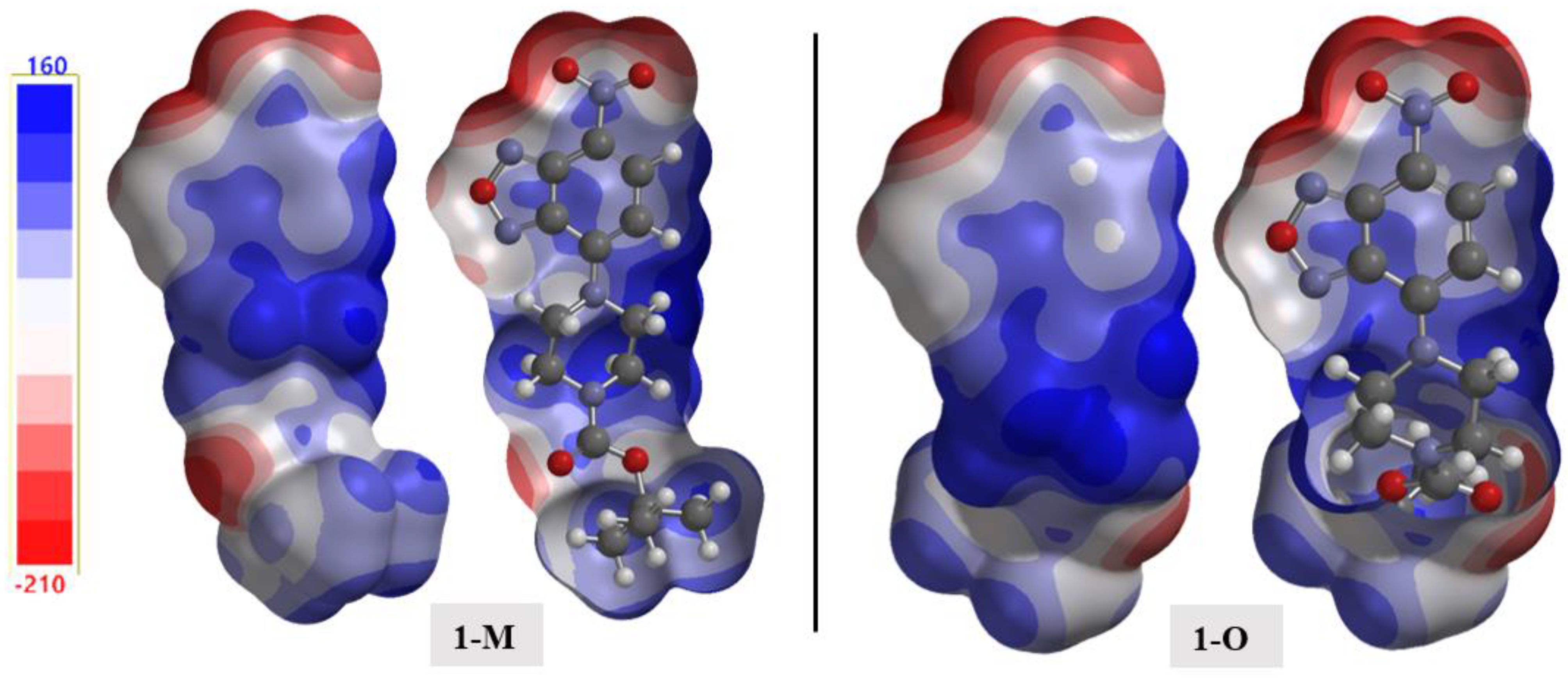
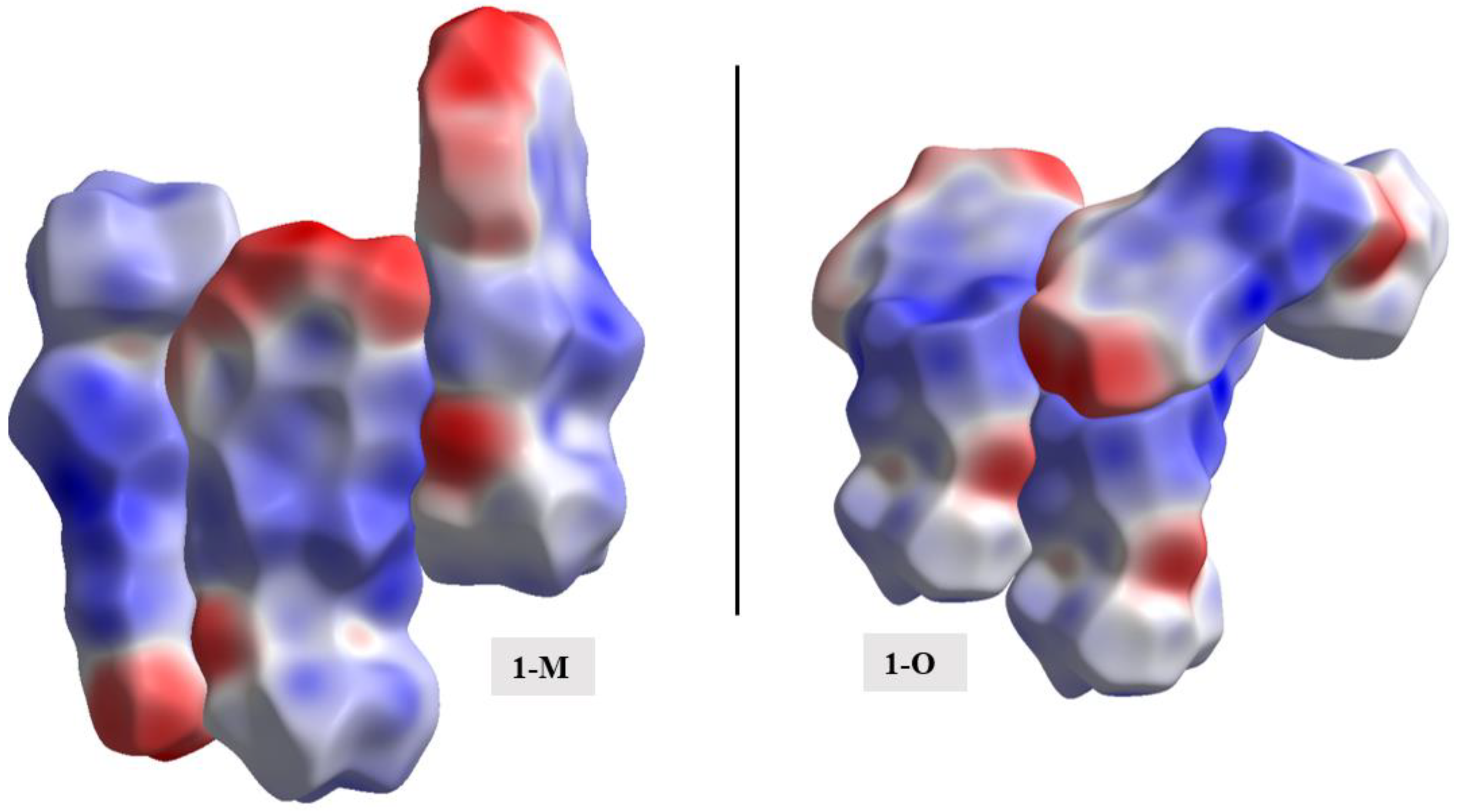
| 1-M | Experimental | Calculated | Difference | 1-O | Experimental | Calculated | Difference | |
|---|---|---|---|---|---|---|---|---|
| O1–N1 | 1.384 | 1.351 | 0.033 | O1–N1 | 1.393 | 1.351 | 0.042 | |
| O1–N2 | 1.369 | 1.338 | 0.031 | O1–N2 | 1.372 | 1.338 | 0.034 | |
| N1–C5 | 1.320 | 1.311 | 0.009 | N1–C5 | 1.317 | 1.311 | 0.006 | |
| N2–C6 | 1.321 | 1.310 | 0.011 | N2–C6 | 1.315 | 1.309 | 0.006 | |
| C1–C2 | 1.390 | 1.390 | 0.000 | C1–C2 | 1.401 | 1.381 | 0.020 | |
| C2–C3 | 1.413 | 1.407 | 0.006 | C2–C3 | 1.400 | 1.414 | −0.014 | |
| C3–C4 | 1.364 | 1.362 | 0.002 | C3–C4 | 1.370 | 1.359 | 0.011 | |
| C4–C5 | 1.425 | 1.424 | 0.001 | C4–C5 | 1.426 | 1.425 | 0.001 | |
| C5–C6 | 1.433 | 1.433 | 0.000 | C5–C6 | 1.442 | 1.430 | 0.012 | |
| C1–C6 | 1.455 | 1.449 | 0.006 | C1–C6 | 1.462 | 1.453 | 0.009 | |
| C1–N3 | 1.366 | 1.350 | 0.016 | C1–N3 | 1.342 | 1.366 | −0.024 | |
| C4–N5 | 1.439 | 1.443 | −0.004 | C4–N5 | 1.428 | 1.448 | −0.020 | |
| N3–C7 | 1.471 | 1.462 | 0.009 | N3–C7 | 1.481 | 1.456 | 0.025 | |
| C7–C8 | 1.522 | 1.523 | −0.001 | C7–C8 | 1.470 | 1.523 | −0.053 | |
| N3–C9 | 1.477 | 1.458 | 0.019 | N3–C9 | 1.499 | 1.468 | 0.031 | |
| C9–C10 | 1.513 | 1.523 | −0.010 | C9–C10 | 1.514 | 1.517 | −0.003 | |
| C8–N4 | 1.456 | 1.445 | 0.011 | C8–N4 | 1.456 | 1.446 | 0.010 | |
| C10–N4 | 1.450 | 1.458 | −0.008 | C10–N4 | 1.470 | 1.448 | 0.022 |
| 1-M | Sym. Op. | R | Eele | Epol | Edis | Erep | Etotal |
|---|---|---|---|---|---|---|---|
| x, −y + 1/2, z + 1/2 | 16.55 | −7.7 | −2.7 | −7.8 | 0.0 | −17.0 | |
| −x, y + 1/2, −z + 1/2 | 5.29 | −13.1 | −6.2 | −50.5 | 31.8 | −42.9 | |
| −x, −y, −z | 9.41 | −19.0 | −4.5 | −20.9 | 13.0 | −33.6 | |
| x, −y + 1/2, z + 1/2 | 8.59 | −11.4 | −6.0 | −29.9 | 21.0 | −29.6 | |
| −x, y + 1/2, −z + 1/2 | 11.37 | −2.8 | −1.6 | −37.2 | 25.3 | −20.9 | |
| −x, −y, −z | 16.56 | −2.8 | −0.4 | −11.7 | 0.0 | −13.5 | |
| −x, −y, −z | 7.02 | −35.1 | −6.8 | −71.6 | 47.9 | −74.8 | |
| x, y, z | 11.91 | −7.4 | −1.4 | −12.6 | 7.3 | −15.3 | |
| 1-O | Sym. Op. | R | Eele | Epol | Edis | Erep | Etotal |
| −x + 1/2, y, z + 1/2 | 6.66 | −22.1 | −8.1 | −66.7 | 42.1 | −61.5 | |
| x, y, z | 9.98 | 3.9 | −0.5 | −3.1 | 0.1 | 1.1 | |
| x, y, z | 6.45 | −10.6 | −6.7 | −40.7 | 28.5 | −34.0 | |
| −x + 1/2, y, z + 1/2 | 9.27 | −23.5 | −6.2 | −18.3 | 18.3 | −34.1 | |
| −x + 1/2, y, z + 1/2 | 9.27 | −4.2 | −2.3 | −8.1 | 3.7 | −11.0 | |
| x, y, z | 7.61 | 4.6 | −1.7 | −14.8 | 7.1 | −4.8 | |
| −x, −y, z + 1/2 | 12.02 | 2.5 | −0.6 | −21.2 | 0.0 | −16.3 | |
| −x, −y, z + 1/2 | 14.47 | −6.5 | −1.4 | −14.7 | 0.0 | −20.7 |
| Compound | VHa | Vcalcb | Globularity | Ovality | Asphericity | Void Space c | Surface Area d | Polar Surface Area e | Dipole Moment f |
|---|---|---|---|---|---|---|---|---|---|
| 1-M | 369.09 | 345.39 | 0.718 | 1.52 | 0.402 | 144.75 | 363.18 | 89.97 | 9.06 |
| 1-O | 403.49 | 323.01 | 0.728 | 1.52 | 0.272 | 198.37 | 362.66 | 88.85 | 8.36 |
Publisher’s Note: MDPI stays neutral with regard to jurisdictional claims in published maps and institutional affiliations. |
© 2022 by the authors. Licensee MDPI, Basel, Switzerland. This article is an open access article distributed under the terms and conditions of the Creative Commons Attribution (CC BY) license (https://creativecommons.org/licenses/by/4.0/).
Share and Cite
Standish, K.; Zeller, M.; Barbosa, A.J.; Hillesheim, P.C. Examining the Non-Covalent Interactions for Two Polymorphs of a 2,1,3-benzoxadiazole Derivative. Crystals 2022, 12, 1143. https://doi.org/10.3390/cryst12081143
Standish K, Zeller M, Barbosa AJ, Hillesheim PC. Examining the Non-Covalent Interactions for Two Polymorphs of a 2,1,3-benzoxadiazole Derivative. Crystals. 2022; 12(8):1143. https://doi.org/10.3390/cryst12081143
Chicago/Turabian StyleStandish, Katherine, Matthias Zeller, Antonio J. Barbosa, and Patrick C. Hillesheim. 2022. "Examining the Non-Covalent Interactions for Two Polymorphs of a 2,1,3-benzoxadiazole Derivative" Crystals 12, no. 8: 1143. https://doi.org/10.3390/cryst12081143






